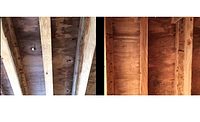Case Study
Large Sewage Loss Proves Quick Work, Product Selection are Key

In late summer 2018, Titan Restoration, based in Mesa, Ariz., was called to a large commercial loss after flash flooding from a summer monsoon storm flooded the property, wiping out power. Due to extensive damage to the resort, the property was completely evacuated, and business temporarily interrupted. Titan Restoration went immediately to work to get the client operational as soon as possible by first focusing on removing more than two million gallons of water, coordinating a temporary power supply, working with the serious security needs of the property, and assessing the extensive environmental cleanup requirements. Titan Restoration was on site by 3 a.m., and worked around the clock to minimize the losses and restore business operation as soon as possible.
For this loss, product choice and usage helped lead to a successful outcome. Careful selection based on experience, product knowledge, and industry relationships allowed the property to be completely restored, disinfected and inspected, ensuring that clients, customers, employees, and management were safe and protected when the resort was reoccupied.
Here’s what the Titan Restoration team had to say about this loss.
- Describe the loss site the first time you stepped on the property?
Water had flooded an area of the resort that housed the main power system and backup generators. The result was a complete loss of power to the resort. Because of safety and security concerns, the property was in the process of being evacuated. Nearly two million gallons of CAT 3 water filled all the lower levels of the resort, and the damage was extensive.
- As you assessed the damage, what were the first things you did?
Our first priority was addressing the security and safety concerns for the resort and its guests. Once the resort was evacuated, we concentrated on coordinating a temporary power supply so that we could start removing the millions of gallons of water that had filled offices, conference rooms, hotel rooms, kitchens, meeting facilities, and especially the service tunnel that housed the main electrical and plumbing for the resort.
- What was the biggest challenge/success on this loss?
By far, the biggest challenge was clearing and disinfecting the 17,000 sq. ft service tunnel that ran under the resort and housed all the electrical and plumbing materials for the property. When the tunnel filled with water from the flash flood, debris in the tunnel broke the sewer lines, leaving the tunnel completely filled and contaminated with 16 feet deep CAT 3 water.
It took a week to clear the debris out the tunnel and then we were under time constraints to get it completely cleaned, sanitized, and pass both air quality and sewage clearance testing. Despite these challenges and because of the proper use of a key remediation product, we were able to pass 538 clearances on the first run.
- Because this was a major CAT 3 flooding event, how did you deal with the resulting odor and microbial control requirements?
In a situation like this, of course, biological and microbial hazards are always the top concern as well as the resulting unpleasant odors. It took us 2 weeks to clear out all of the debris, and wash down the tunnel with a fire hose and vacuum trucks. The resort then told us we had the weekend to sanitized and and pass clearance tests in the tunnel. We had eight of our guys suit up with PPE, including respirators, to apply ProKure liquid and gas treatments to the walls, floors, and ceiling of the tunnel. Within two days of application, we passed all our clearance tests, including air tests and sewage swabs, allowing close to 200 electricians and plumbers access to the tunnel so they could start their portion of the restoration job.
- Describe the products you used to address odor and other antimicrobial mitigation?
We used both ProKure V (Liquid Disinfectant/Fungicide/Deodorizer) and ProKure G (ClO2 Deodorizer) to treat the tunnel. In liquid form, Titan Restoration treated the floor, walls, and ceiling along with all the mechanical pipes and electrical conduits. After the liquid application, we used ProKure G to eliminate any odor-causing bacteria, mold and mildew or other foul odors that remained.
The important thing about the chlorine dioxide (“ClO2”) that ProKure uses is that it doesn’t hydrolyze in the water, but remains as a dissolved gas. This allows it to act as a gas once it’s applied and fill the entire space, giving you complete microbial coverage. Even tiny, microscopic cracks and crevices are penetrated by the gas.
- What surprised you most about using chlorine dioxide on this job?
The most surprising thing for us was how effective ClO2 was at allowing us to pass clearance tests the first time. It speaks to the effectiveness and advancement of the product that one application completely eliminated any odor and all microbes.
- What advice would you offer other restorers who might find themselves headed to an unexpected large loss like this?
This was a huge loss for our client, in both revenue and reputation, and they were dependent on us to get them up and running as soon as possible. The damage was extensive, the losses were significant, the risks to safety were high, and time was of the essence.
The seven-week mitigation required 250 technicians and over 24,000 man hours. In addition to cleaning and disinfecting the maintenance tunnel, our team restored the entire property, removing and replacing over 31,000 square feet of drywall. We were proud of the work we did. However, we could not have moved forward with the restoration in such a timely and effective way without being able to ensure complete deodorization and disinfection of all areas of the property. This was one of the most critical components of the job and our clients were counting on us to get it right the first time.
Any restorer who works a CAT loss needs disinfection products that they can count on. Their work and their reputations are dependent on their ability to completely eliminate any biological threats. Correct product selection made a huge difference for us and our client, and ultimately, led to the successful completion of one of the largest remediation projects in Arizona history.
Looking for a reprint of this article?
From high-res PDFs to custom plaques, order your copy today!





